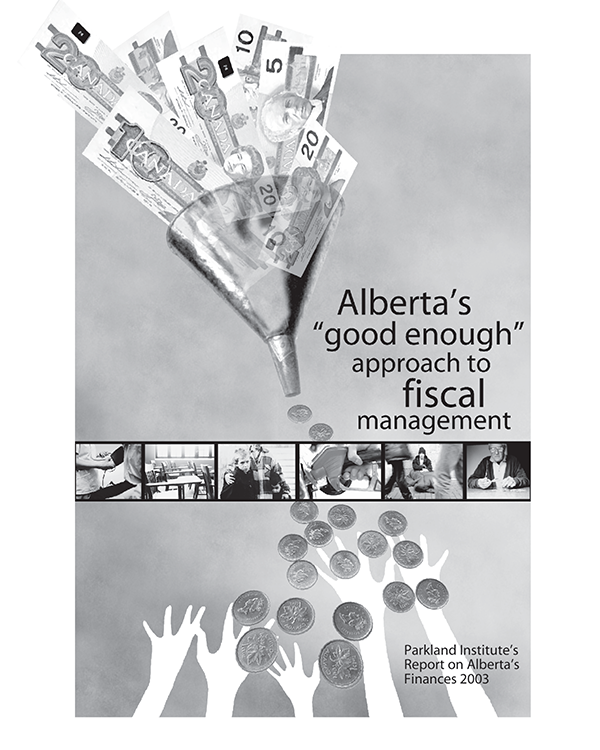Executive summary

“Alberta’s ‘good enough’ approach to fiscal management” is the Parkland Institute’s annual pre-budget report on the state of Alberta’s finances.
The report examines in detail the province’s current revenue structure and recent expenditures with special concentration given to the areas of health, education, and social services.
The report also looks both at the government’s current plans to resort to Public-Private Partnerships, or P3s, to resolve a growing infrastructure crisis and, more generally, its current practices regarding fiscal accountability.
Finally, the report makes a series of recommendations regarding the government’s revenue sources, spending priorities, and accounting practices.
Highlights
- Although Alberta’s economy grew by almost half between 1992 and 2001, and job creation and population growth have been robust, inflation has been higher than the national average for most of the last ten years.
- Government deregulation of energy, the short-lived rebate and credit program for energy, and sky-rocketing energy prices have resulted in tremendous volatility in the inflation rate.
- People, however, are not necessarily seeing the benefits of a rosy economic picture. Real earnings in Alberta have remained largely stagnant – increasing by just 2.8 percent between 1991 and 2001, resulting in a steady decline in the purchasing power of working Albertans.
- Provincial government revenues have exceeded expenditures in every year since 1995 with the exception of 2002.
- Parkland Institute predicts Alberta’s surplus for the fiscal year 2002-2003 will be between $2.0 billion and $2.5 billion, barring significant unreported spending. The government continues to justify tight budgets by being extremely conservative in it’s budget assumptions regarding energy prices.
- Alberta’s revenue streams remain unstable as a result of over-reliance upon resource royalties, compared with other provinces, and an under-reliance upon tax revenues.
- Although overall Alberta taxes individuals at a much lower rate than the national average, those Albertans with taxable incomes between $30,000 and $70,000 pay far more in taxes than their counterparts in Ontario and British Columbia. Conversely, Albertans earning $150,000 annually pay significantly less than in BC and Ontario.
- Contrary to the government’s own claims, per capita health care spending in real dollars only recovered to 1993 levels in 2001 – health care spending has not been “out of control” for most of the past decade.
- Moving towards private models of health care will increase the overall costs of health care to individuals and to society, including businesses outside of the private health care industry.
- Government focus on the increase in per capita education spending is deceptive. Per student funding in 2002 fell just short of $4,500 and will only be slightly above this figure in 2004. By comparison, per student funding was as high as $5,229 in 1987 and even $4,734 as recently as 1994. The government’s glowing promises in Budget 2002 to reinvest in education have proved hollow.
- Government spending per student in post-secondary education is about the same today as it was in 1995. Tuition for students has risen sharply in the same period. The aggregate amount of outstanding student loans was 6.2 times higher in 1999 than in 1984 and the average student debt in Alberta today is $18,397.
- Alberta’s social allowance rates are the lowest in Canada and have not changed since 1993 when they were reduced by 20 percent. After adjusting for inflation, the real benefits received by social allowance recipients are now 40% lower than they were a decade ago.
- Alberta, the wealthiest province in the country, currently has the lowest minimum wage in the country. This, of course, impacts other wages in the province, as well as the number of people on social assistance, given the fine line between a minimum wage earner and a social assistance recipient in terms of income.
- Public-Private Partnerships (P3s) are unacceptable and unjustifiable in a province with the fiscal capacity to make alternative choices, and they represent a drastic undemocratic shift in power, authority, and accountability.
Based on the above points and analysis, and consultations with numerous experts in various fields, the Parkland Institute goes on to make a number of policy recommendations as the provincial government prepares its annual budget for 2003.
Conclusion
Albertans have a choice to make. Like parents everywhere, they can be happy with their province remining an “under-achieving” student bringing home a “C” on his or her report card. Or they can demand the province live up to its potential and bring home an “A.” Sometimes, “good enough” just isn’t good enough – and that time is now.
Related reading
Get timely research and analysis from Parkland in your inbox.
Subscribe to email from ParklandYour donation supports research for the common good.
Donate to Parkland Institute